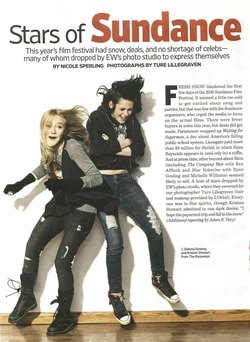Two recent articles in Entertainment Weekly about the Sundance Film Festival failed to mention that EW is one of Sundance's biggest sponsors, and has been for 19 years. One was a photo essay of celebrities that appeared in the Feb. 5, 2010 issue, and the other a roundup of the films at Sundance by venerated critics Owen Gleiberman and Lisa Schwarzbaum in the February 12 issue. Neither story mentioned that Entertainment Weekly was one of only four presenting sponsors of the festival this year (along with Hewlett Packard, Honda, and Sundance Channel) - the highest tier of sponsorship at the festival.
Though I'll be the first to acknowledge that "entertainment journalism" is an oxymoron, the two decade-long relationship between the magazine and the festival is still striking for its brazen coziness. It's true that most film festivals rely on media sponsorships to help promote themselves, but usually this is manifest in the form of well-placed ads, which indeed EW has provided for Sundance. But other media outlets handle these relationships more transparently. For example, when the Los Angeles Times Calendar section reports on the Los Angeles Film Festival, it always includes the disclaimer that the newspaper is a sponsor of the festival.
So the question is what is the quid-pro-quo when editorial and "photo-torial" coverage for the festival is included? When EW boasts of it's "exclusive" star portraits at the EW "photo studio" in Park City with the likes of Kristen Stewart, Elijah Wood, and Naomi Watts, was that exclusivity procured because of its festival sponsorship or because they have more talented photographers than those working for AP or WireImage? Did the festival provide the location for the makeshift studio and did the festival publicity office help schedule the celebrities who were photographed? And stranger still, why photograph celebrities in one of the most scenic ski resorts in America only to bring them inside and shoot them against a plain white wall? If it weren't for Orlando Bloom wearing a scarf, one could be forgiven for thinking these were taken in LA, New York or Cannes. If I was Sundance, I might consider providing EW a studio with a window next time.
Owen Gleiberman and Lisa Schwarzbaum are arguably two of the best film critics in the country. But to what extent are they good journalists when they don't disclose their magazine's cozy relationship with Sundance? As credentialed press members, do they have easier access to screenings, interviews, transportation, lodging or parties? I don't know. But I would be hard pressed to come up with an example in the last 16 years of either of them reviewing a film at one of the alternative film festivals in Park City (including Slamdance, of which I am a co-founder. See! Full disclosure. That's not so hard). EW has rarely mentioned Slamdance in its print version, and usually only after one of our films - like Paranormal Activity - finds success. But had Gleiberman or Schwarzbaum actually seen the film in Park City two years ago, perhaps its success might not have been such a tortuous journey from when Dreamworks first acquired the rights to it at the festival. Other filmmakers they might have spotted early on in their careers include Christopher Nolan, Marc Forster, Greg Mottola and Jared Hess. Sadly, EW readers would never have known their first films played in a Park City festival that didn't have a sponsorship deal with the magazine.
Why should anyone care about this? With the demise of other entertainment print magazines like Premiere, the descent into paparazzi coverage of magazines like US Weekly, the vast cutbacks in film review staffs at newspapers like the LA Times, and the shrinkage of trade publications Variety and The Hollywood Reporter, Entertainment Weekly holds a near-monopoly on national print film reviews (not to mention TV and book reviews). EW's reviews - even a passing mention - carry tremendous weight, especially with independent films that are on the cusp of getting distribution, which they usually are in Park City. And don't forget: Entertainment Weekly is also a subsidiary of Time Warner (something else that frequently goes unmentioned in reviews of Warner Bros. or New Line films). As Spiderman might say: with great power comes great responsibility...at least for full disclosure.
